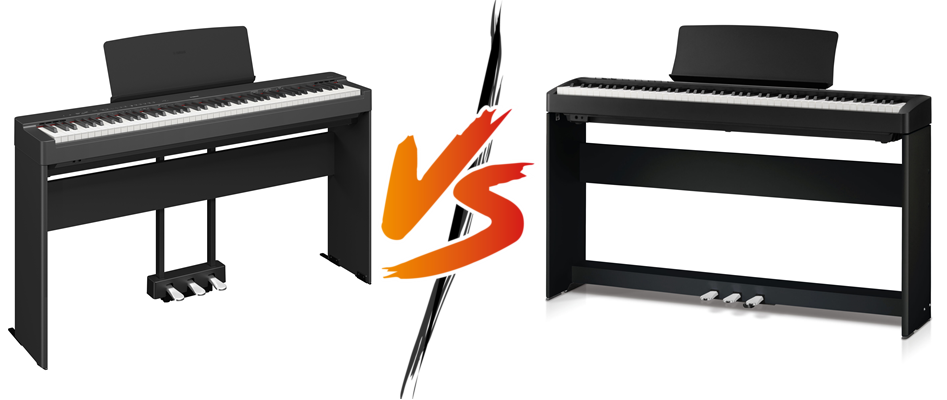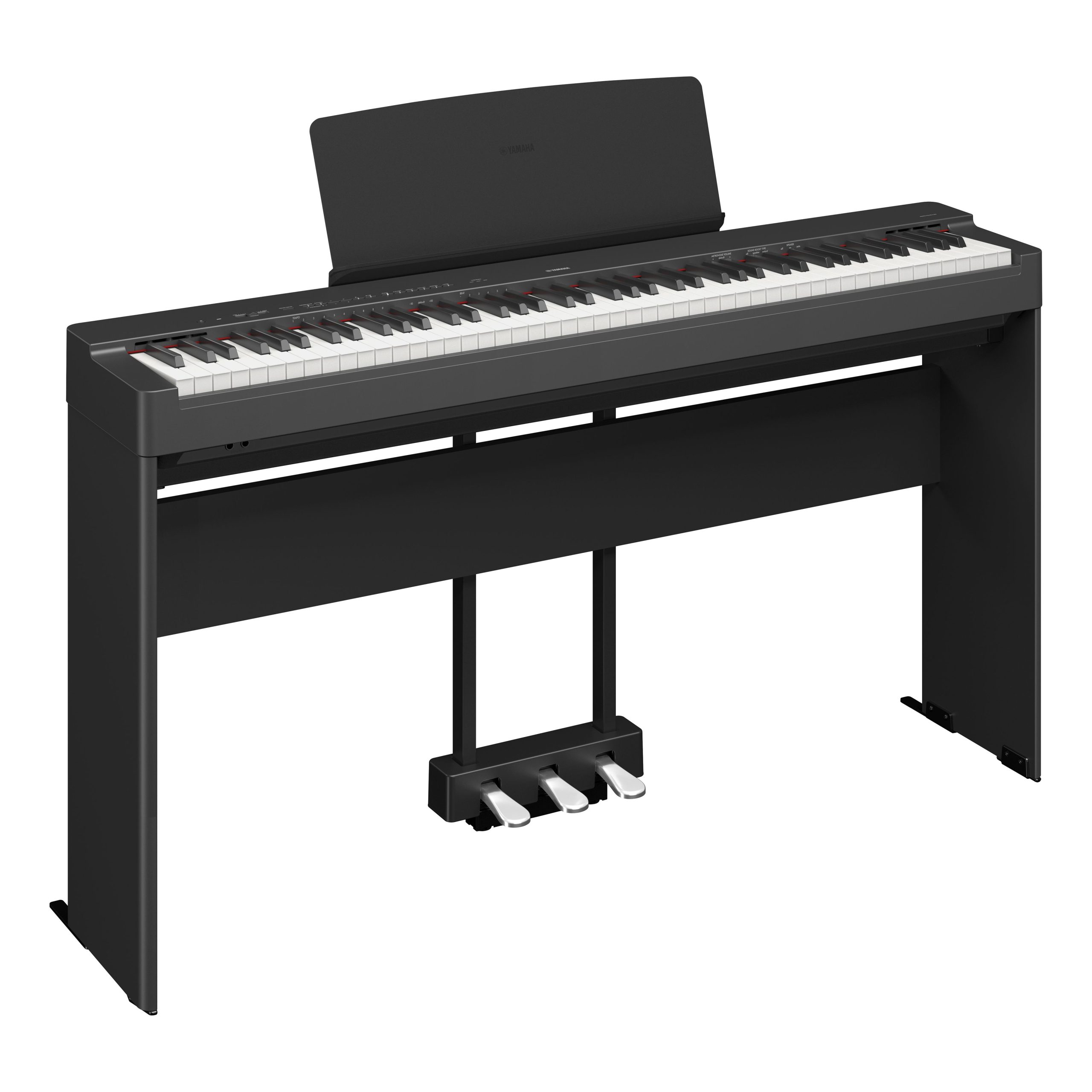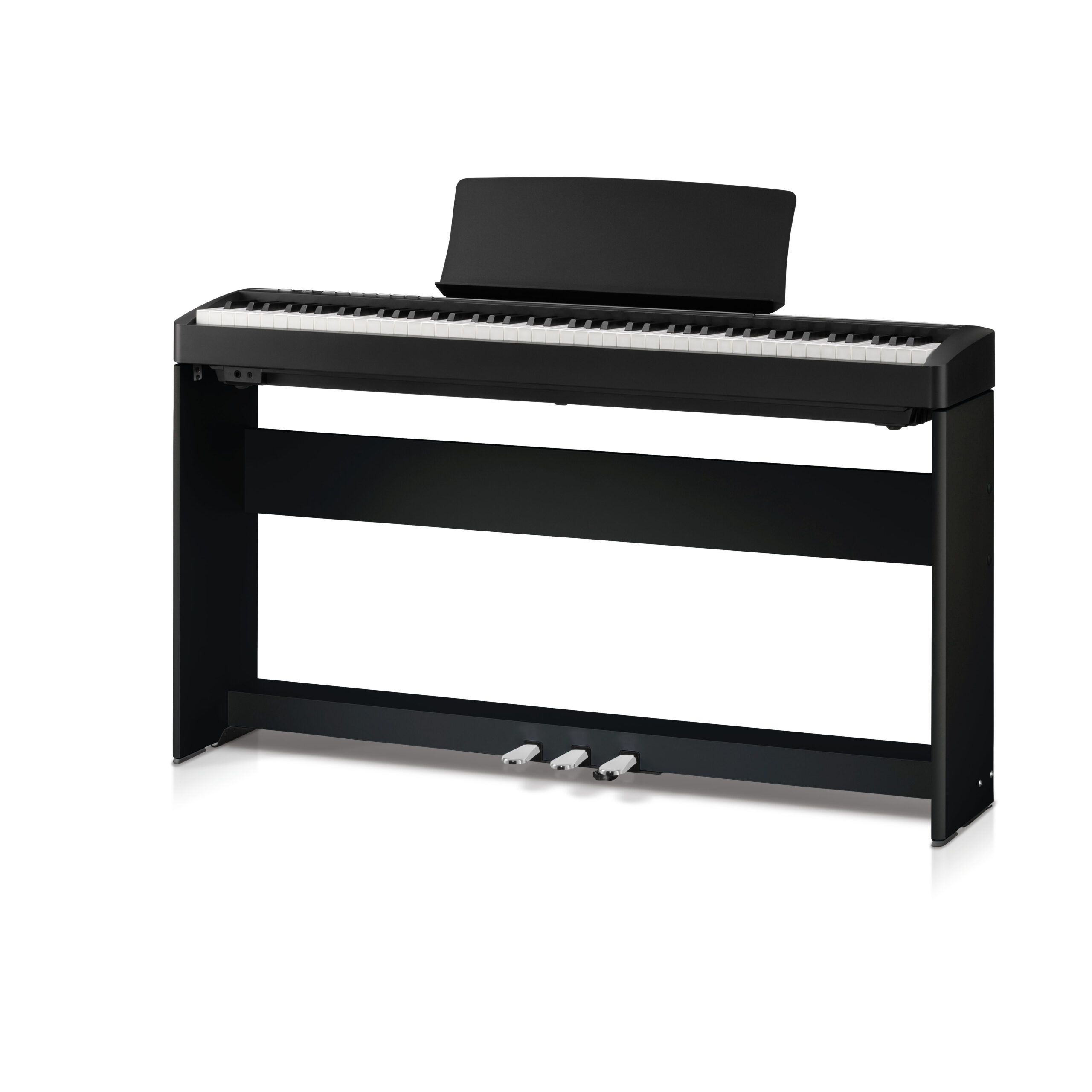
The world of digital pianos is vast, with many models offering features that rival even the best acoustic pianos. Two such contenders in the mid-range market are the Yamaha P225 and the Kawai ES120, both from well-established brands known for their legacy in piano manufacturing. Whether you are a beginner, an intermediate player, or an experienced pianist looking for a compact solution, these two models offer a blend of realistic piano sound, essential features, and convenience.
In this comparison review, we’ll explore how the Yamaha P225 vs Kawai ES120 stack up against each other across various aspects like design, keyboard action, sound quality, speaker systems, functionality, connectivity options, and overall value for money. By the end, you should have a clearer idea of which digital piano best suits your needs.
Yamaha P225 vs Kawai ES120 Comparison Chart
Here’s a comparison table that summarizes the specifications and key features of the Yamaha P225 and Kawai ES120:
If you click the links below, under the product images you will be redirected to Amazon.com. In case you then decide to buy anything, Amazon.com will pay me a commission. This doesn’t affect the honesty of this review in any way though.
| Feature | Yamaha P225 | Kawai ES120 |
|---|---|---|
 |  | |
| Check best price on Amazon | Check best price on Amazon | |
| Keyboard Action | Graded Hammer Standard (GHS) | Responsive Hammer Compact (RHC) |
| Key Material | Matte Plastic | Matte Plastic (Ivory-like texture) |
| Touch Sensitivity | 3 levels + Fixed | 3 levels + Fixed |
| Sound Engine | Pure CF Sound Engine | Harmonic Imaging (HI) |
| Piano Sample | Yamaha CFIIIS Concert Grand | Shigeru Kawai SK-EX & Kawai EX Concert Grands |
| Polyphony | 192-note | 192-note |
| Number of Sounds | 24 (10 pianos + 14 other sounds) | 25 (10 pianos + 15 other sounds) |
| Speakers | 2 x 12W (24W total) | 2 x 20W (40W total) |
| Modes | Dual, Split | Dual, Split, Four-Hands |
| Recording & Playback | MIDI recording/playback (1 song) | MIDI recording/playback (3 songs) |
| Bluetooth | No | Bluetooth MIDI and Audio |
| USB Connectivity | USB-to-host | USB-to-host + 5-pin MIDI |
| Line Outputs | Yes (2 x 1/4″ jacks) | Yes (2 x 1/4″ jacks) |
| Headphone Outputs | 2 x 1/4″ stereo jacks | 2 x 1/4″ stereo jacks |
| Virtual Technician (Sound Customization) | No | Yes (adjusts resonance, hammer noise, etc.) |
| App Integration | Smart Pianist App | PianoRemote and PiaBookPlayer Apps |
| Dimensions (WxHxD) | 52.19″ x 6.53″ x 11.56″ | 51.57″ x 5.83″ x 13.78″ |
| Weight | 12 kg (26.4 lbs) | 12.5 kg (27.5 lbs) |
| Finish Options | Black, White | Black, White |
| Price Range | Lower mid-range | Slightly higher mid-range |
| Yamaha P225 review | Kawai ES120 review |
Key Takeaways from the Table:
- Keyboard Action: The Kawai ES120’s RHC action offers a slightly more authentic feel compared to Yamaha’s GHS, making it better suited for those who prioritize the piano-like touch.
- Sound Engine: Both pianos use high-quality samples, but the Kawai ES120 leans towards a warmer and richer sound with its Shigeru Kawai grand piano samples.
- Speakers: The Kawai ES120 has more powerful speakers (40W compared to Yamaha’s 24W), which provides a fuller, more resonant sound.
- Bluetooth: Kawai wins in this category with built-in Bluetooth MIDI and audio, while the Yamaha P225 lacks this feature.
- Portability: Both pianos are highly portable, but the Yamaha is slightly more compact and lighter.
- Value for Money: The Yamaha P225 is more budget-friendly, but the Kawai ES120 offers more premium features like Virtual Technician and Bluetooth.
This table should help in a quick, side-by-side comparison of the two models based on your specific needs!
Design and Build Quality
Yamaha P225 Design
The Yamaha P225 is the latest addition to Yamaha’s P-series, a product line well-known for delivering lightweight, portable digital pianos with a minimalist aesthetic. The P225 continues this tradition, boasting a sleek, compact design that is ideal for home use or performance settings.
- Dimensions: The P225 is relatively slim and can fit comfortably into smaller spaces, whether in a bedroom, living room, or studio.
- Weight: It weighs about 12kg (26.4 lbs), making it fairly light for a full 88-key digital piano, and easy to carry around.
- Material: The finish is mostly matte, with smooth plastic surfaces. The overall look is modern, with a practical focus on portability.
- Aesthetics: The design isn’t flashy but has a professional feel. The minimalistic control panel keeps the top surface uncluttered, perfect for musicians who prefer a simple, distraction-free interface.
Kawai ES120 Design
Kawai, known for its craftsmanship in acoustic pianos, brings that same attention to detail to its digital models. The ES120 embodies the company’s philosophy of blending form and function while maintaining a premium feel.
- Dimensions: Similar in size to the Yamaha P225, the Kawai ES120 is also compact, though slightly bulkier due to its slightly higher key bed.
- Weight: At 12.5kg (27.5 lbs), it’s almost on par with the Yamaha, making it portable but with a slightly more robust build.
- Material: Kawai uses a matte finish as well, though some reviewers may argue that the ES120 feels more substantial and durable due to its thicker build.
- Aesthetics: The ES120 looks elegant, with subtle design elements like rounded edges that lend it a classic, refined look. Its control panel is equally minimalist, giving a modern appearance with a touch of tradition.
Verdict: Both pianos have solid designs, but the Yamaha P225 feels more streamlined and portable, while the Kawai ES120 leans toward a slightly more substantial build with a refined finish. If portability is your main criterion, the Yamaha edges ahead, but if you’re after a durable, premium feel, the Kawai has the upper hand.
Keyboard Action and Feel
Yamaha P225 Keyboard
The keyboard is arguably the most important feature of any digital piano, and the Yamaha P225 doesn’t disappoint. Yamaha equips the P225 with its latest GHS (Graded Hammer Standard) action, which emulates the feel of an acoustic piano by providing heavier resistance in the lower keys and lighter resistance in the higher keys.
- Touch Sensitivity: The P225 allows you to adjust the touch sensitivity with several levels, catering to both lighter and heavier-handed players.
- Key Material: The keys are plastic, with a matte finish that reduces slippage during long practice sessions.
- Feel: While the GHS action is impressive for its price point, it may still feel a bit lighter than a real acoustic piano. The P225 is designed for pianists who may transition between acoustic and digital regularly.
Kawai ES120 Keyboard
The Kawai ES120 features the Responsive Hammer Compact (RHC) action, an improved version of the key action found in its predecessor. Kawai is known for its realistic key action, and this model brings a more authentic feel closer to an acoustic piano.
- Touch Sensitivity: Like Yamaha, Kawai offers several levels of touch sensitivity, ensuring a personalized experience.
- Key Material: The keys are made of plastic as well, but Kawai’s texture has a more premium feel, resembling ivory, giving the pianist better tactile control.
- Feel: The RHC action feels slightly more substantial and realistic compared to Yamaha’s GHS. The heavier weight in the lower register is more pronounced, offering a better imitation of an acoustic piano, which may appeal to advanced players.
Verdict: The Kawai ES120 provides a more authentic piano feel, thanks to its RHC action, which offers slightly more resistance and key weight compared to Yamaha’s GHS. While Yamaha’s keyboard action is good for beginners and intermediate players, Kawai’s action will likely appeal more to experienced pianists.
Sound Quality and Acoustic Emulation
Yamaha P225 Sound
Yamaha is renowned for its high-quality sound sampling, and the P225 benefits from Yamaha’s Pure CF Sound Engine. The samples are taken from Yamaha’s renowned CFIIIS concert grand piano, and the P225 reproduces them with impressive fidelity.
- Piano Sounds: The piano tones are rich, clear, and dynamic. The tonal color varies depending on how hard or soft you press the keys, adding expressiveness to the performance.
- Sound Settings: The P225 offers several different piano sound types (Bright, Mellow, Grand Piano, etc.), along with electric pianos, organs, and strings.
- Polyphony: With 192-note polyphony, you can play complex passages with the sustain pedal without worrying about note drop-offs.
Kawai ES120 Sound
The Kawai ES120 uses the Harmonic Imaging (HI) sound engine, which features high-quality samples of Kawai’s Shigeru Kawai SK-EX and Kawai EX concert grand pianos.
- Piano Sounds: The ES120 excels in reproducing the warmth and richness of an acoustic grand piano. The timbral range is broad, with nuanced expressiveness that responds well to different playing techniques.
- Sound Settings: Like the Yamaha P225, the Kawai ES120 includes a variety of piano tones, electric pianos, organs, and strings, giving you plenty of sonic variety.
- Polyphony: The ES120 also offers 192-note polyphony, ensuring you can play complex compositions without losing notes.
Verdict: Both models offer excellent sound quality, but they have distinct tonal characters. The Yamaha P225 is bright and clear, while the Kawai ES120 leans towards a warmer, richer sound. The Kawai excels in delivering a more nuanced and expressive grand piano experience, while Yamaha is slightly more versatile in its tonal variety.
Speaker System
Yamaha P225 Speakers
The Yamaha P225 is equipped with two 12W speakers, providing a total of 24W of power. These speakers are well-tuned for the size of the piano, projecting a clean, crisp sound.
- Sound Projection: The sound is clear at lower volumes, making it suitable for home use, but it also holds up when cranked higher, making it usable in small performance settings.
- Bass and Treble Balance: The P225 offers a balanced tone across the frequency range, but the bass, while present, isn’t as powerful as you’d find in higher-end models or acoustic pianos.
Kawai ES120 Speakers
The Kawai ES120 comes with dual 20W speakers, totaling 40W of output, which is more powerful than the Yamaha P225.
- Sound Projection: The ES120 has a fuller sound that can easily fill a room. The bass is particularly deep and resonant, which enhances the realism of the acoustic piano sounds.
- Bass and Treble Balance: With a broader dynamic range, the ES120 offers a more pronounced low-end compared to the Yamaha, making it a more immersive listening experience, especially for classical or jazz pianists.
Verdict: The Kawai ES120 has a more powerful and fuller sound, thanks to its superior speaker system. If sound projection and depth are crucial for you, especially for performances in larger spaces or for more resonant bass frequencies, the ES120 is the better choice.
Features and Functionality
Yamaha P225 Features
The Yamaha P225 comes with several features that make it versatile for both practice and performance:
- Recording and Playback: The built-in recording feature allows you to capture your performances easily. You can record and playback MIDI files, which is useful for students and performers alike.
- Modes: It features a Dual Mode, which allows you to layer two sounds (e.g., piano and strings), and Split Mode, which lets you assign different sounds to the lower and upper halves of the keyboard.
- Smart Pianist App: Yamaha’s Smart Pianist app provides an intuitive way to control the piano’s functions, including voice selection, adjusting sound, and accessing practice features.
Kawai ES120 Features
Kawai also loads the ES120 with plenty of useful functions for a wide range of players:
- Recording and Playback: Similar to the Yamaha, the Kawai ES120 offers MIDI recording and playback features.
- Modes: The ES120 includes Split Mode, Dual Mode, and a Four-Hands Mode, which is ideal for teaching situations where a teacher and student can sit side by side and play the same octave range.
- Virtual Technician: Kawai’s Virtual Technician feature lets you fine-tune the piano’s tone to your liking, adjusting aspects like hammer noise, damper resonance, and string resonance.
Verdict: Both models are feature-rich, but Kawai’s Virtual Technician gives it an edge for pianists who like to tweak their sound. Yamaha’s Smart Pianist app is more intuitive for beginners and intermediate players who want more accessible controls.
Connectivity
Yamaha P225 Connectivity
- MIDI: The P225 includes USB-to-host connectivity, allowing you to connect the piano to a computer or smart device for MIDI control.
- Audio: It has a headphone output and two 1/4″ line outputs, making it suitable for external amplification or recording setups.
- Bluetooth: The P225 does not feature built-in Bluetooth for MIDI or audio, which might be a downside for players who prefer wireless connectivity.
Kawai ES120 Connectivity
- MIDI: The ES120 offers USB-to-host and traditional 5-pin MIDI connections, giving it more flexibility in terms of MIDI options.
- Audio: Like the Yamaha, the ES120 also features headphone outputs and 1/4″ line outputs.
- Bluetooth: The Kawai ES120 has Bluetooth MIDI and Bluetooth Audio, allowing you to connect wirelessly to apps, DAWs, or even play music through the piano’s speakers.
Verdict: The Kawai ES120 takes the lead in this category due to its built-in Bluetooth functionality, which gives you more flexibility for wireless practice and recording.
Portability and Practical Use
Both the Yamaha P225 and Kawai ES120 are designed with portability in mind. Their compact and lightweight builds make them ideal for gigging musicians or those who need to move the piano between rooms.
- Yamaha P225: Slightly lighter and more compact, making it easier to transport.
- Kawai ES120: Slightly heavier but still manageable, especially considering its added durability and features.
Verdict: The Yamaha P225 is marginally more portable, but the difference in weight is minimal. Both models are great for musicians on the go.
Value for Money
Yamaha P225 Pricing
The Yamaha P225 sits comfortably in the mid-range digital piano market, offering excellent value for its price. It is slightly more affordable than the Kawai ES120, which may appeal to budget-conscious buyers who still want a reliable, good-sounding digital piano.
Kawai ES120 Pricing
The Kawai ES120 is priced slightly higher than the Yamaha P225, but with its superior keyboard action, sound engine, and features like Bluetooth connectivity and Virtual Technician, it offers more value to players seeking a premium experience.
Verdict: The Yamaha P225 offers great value for beginners or those looking for a high-quality yet affordable digital piano. However, the Kawai ES120 provides more features and a more authentic piano experience, making it worth the slightly higher price tag for intermediate and advanced players.
Conclusion: Which One Should You Choose?
Both the Yamaha P225 and the Kawai ES120 are outstanding digital pianos in their own right, and choosing between them depends largely on your priorities.
- If you are looking for portability, ease of use, and affordability, the Yamaha P225 is an excellent option. It provides a bright and dynamic sound, a solid keyboard action, and good overall features, all at a lower price point.
- If you prioritize a more authentic piano feel, richer sound quality, and advanced features like Bluetooth and sound customization, the Kawai ES120 is the superior choice. It excels in its keyboard action, speaker system, and sound quality, making it ideal for serious pianists.
Ultimately, you can’t go wrong with either model, but the Kawai ES120 offers a more refined experience for those willing to invest a bit more, while the Yamaha P225 is a fantastic, cost-effective option for a wide range of players.
